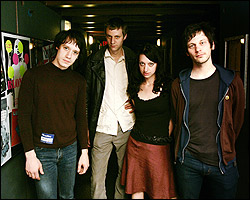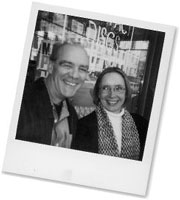IF YOU’RE FAMILIAR with the ultra-efficient practices of ultramodern coupling, you know about speed dating, whereby expeditious singles complete a dozen or so 10-minute “dates” in a single evening. They’re really just frantically sizing up the stats of potential mates and racing to keep a running tally of the best options, but apparently, it works for some people. A few Mondays ago at SAM, the notion behind speed dating worked for some people, too, but the matchmaking was of a different sort.
The 34 local chefs and retail buyers who mixed and mingled with 55 regional fishermen and seafood harvesters in the museum’s meeting rooms were participating in Seattle’s first Fisherman-Chef Connection, a daylong event organized by local food industry professionals and environmentalists from Ecotrust and Pacific Marine Conservation Council, based on a similar effort in Portland. Before and after the speed-dating round, there were workshops and panel discussions about salmon farming (not good), frozen-at-sea technologies (potentially very good), and direct marketing between the hands that catch and the hands that grill (great). The overall idea was simple: Put the two parties in the same room, allow them to discuss their needs, and let nature take its course. That course should end at your plate where responsibly caught, responsibly managed seafood is responsibly, and deliciously, presented.
For chefs like Charles Ramseyer of Ray’s Boathouse, these relationships and these issues are crucial because his restaurant specializes in seafood, and plenty of it. Although he has to deal with the big distributors in order to keep his stock up, he also buys as much as he can from independent boats because in the best-case scenario, the seared scallops in front of you have only been handled by someone in fishermen gloves and someone in chef’s baggies.
But all too often, fish go from there to here only to be shipped back over there so it can be cut and frozen by these guys and packed and labeled by some other guys. As Ramseyer illustrated by way of a story about how he no longer drives to Sea-Tac to pick up fish flown from Alaska, time is money, and it’s getting harder and harder for fishermen to operate on a DIY model. Because airlines are increasingly apt to favor the cargo customer who has the most cargo, he who spends the most gets on board first—and the little guys often get edged out. Ramseyer doesn’t drive to the airport anymore because there aren’t many single-boat fishermen overnighting their catch to individual chefs these days. It’s the same big, bad business story you’ve heard applied to other facets of life. In fish markets, as in dating, as in just about everything else, nice guys don’t always finish first.
WILL THERE BE a rash of second dates? Absolutely. (To make things easier, the event organizers are even publishing a little black book of sorts.) For Bill Whitbeck of Taylor Shellfish, those dates will be more of the same: More direct deliveries to restaurants like Chiso (where chef Tai Chi Kitamura is experimenting with their geoduck), and more truly direct marketing to consumers at neighborhood farmers markets. Relationships like the one between fisherman Joe Malley and chef Jonathon Sundstrom will continue to evolve—Malley’s tuna and his troller get top billing at Lark; the menu frequently offers “St. Jude’s albacore.” And I suspect the phone will ring off the hook for fishermen like Bruce Gore, who pioneered an increasingly popular method for independent boats to freeze their catch at sea, thereby allowing them independence from corporate processors and extending your seafood-eating season by supplying restaurants (like Ramseyer’s) with quality catch that keeps well.
So the next time you take someone out to dinner, you might consider asking your server about the restaurant’s mating habits. When you support local and regional fishermen and the effort to shorten “food miles,” you’re not just eating well and supporting your own economy, you’re spreading the love.







